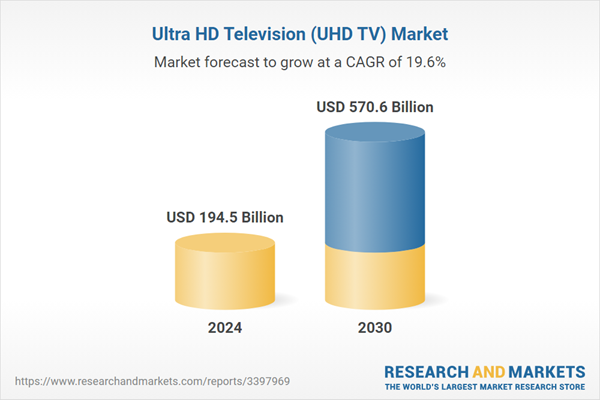The global market for Ultra HD Television (UHD TV) was valued at US$194.5 Billion in 2024 and is projected to reach US$570.6 Billion by 2030, growing at a CAGR of 19.6% from 2024 to 2030. This comprehensive report provides an in-depth analysis of market trends, drivers, and forecasts, helping you make informed business decisions. The report includes the most recent global tariff developments and how they impact the Ultra HD Television (UHD TV) market.
The demand for UHD TVs is propelled by several factors, primarily by the continuous advancements in content availability and the enhancements in TV technology itself. There is a significant increase in the production of UHD content, including movies, TV shows, and streaming options, as content providers and broadcasters aim to meet the growing consumer demand for higher-quality visual experiences. This move is strategic for broadcasters to enhance service offerings and secure a competitive edge by delivering more engaging and detailed visuals. Moreover, global sporting events and other significant broadcasts in 4K resolution encourage viewers to adopt UHD TVs to enjoy these spectacles in the best possible quality. On the technology front, improvements such as larger screen sizes, integration with smart home technologies, and advancements in color and brightness technologies (like Quantum Dot and OLED) are making UHD TVs more appealing. These TVs not only offer superior picture quality but also integrate seamlessly with other smart devices, enhancing overall user convenience and entertainment experience.
The growth of the UHD TV market is also influenced by broader technological and socio-economic trends. Increasing affordability, due to reduced production costs and intensified market competition, has made UHD TVs more accessible to a wider audience, encouraging upgrades from standard or high-definition models. The integration of UHD TVs with contemporary gaming systems, which can utilize the TVs' capabilities to deliver immersive gaming experiences, serves as another critical growth driver. Furthermore, the expansion of broadband and connectivity solutions, like fiber-optic networks and 5G, supports the streaming of high-resolution content, which is optimal for UHD viewing. Demographic shifts and increasing consumer lifestyle changes toward luxury and premium home entertainment options also fuel the demand for UHD TVs. In professional settings, such as corporate boardrooms and educational institutions, the superior resolution and display capabilities of UHD TVs make them increasingly preferred for presentations and multimedia content, enhancing communication and learning experiences. These multifaceted drivers ensure that UHD TVs continue to be a significant component of modern home and professional environments, pushing forward the boundaries of how visual media is experienced.
Segments: Resolution (4K, 8K); Display Type (LED, OLED, QLED).
Geographic Regions/Countries: World; United States; Canada; Japan; China; Europe (France; Germany; Italy; United Kingdom; and Rest of Europe); Asia-Pacific; Rest of World.
The analysts continuously track trade developments worldwide, drawing insights from leading global economists and over 200 industry and policy institutions, including think tanks, trade organizations, and national economic advisory bodies. This intelligence is integrated into forecasting models to provide timely, data-driven analysis of emerging risks and opportunities.
Global Ultra HD Television (UHD TV) Market - Key Trends and Drivers Summarized
Ultra High Definition (UHD) TVs, commonly known as 4K TVs, represent a significant evolution in television technology, offering viewers an unprecedented level of detail and clarity. The core advantage of UHD TVs lies in their resolution of 3840 x 2160 pixels, which is four times that of Full HD. This higher resolution is achieved through advanced display technologies such as LCD, LED, or OLED panels, which allow for smaller pixels and thus a higher pixel density. As a result, images on UHD TVs appear sharper and more lifelike, especially noticeable on larger screens or when viewed from closer distances. High Dynamic Range (HDR) technology complements this by enhancing contrast and brightness, providing a richer and more dynamic visual experience. To access the full potential of UHD, consumers require compatible content sources like UHD Blu-ray players or specific streaming services that offer content in 4K resolution. Additionally, UHD TVs are capable of upscaling lower-resolution content to near 4K quality, enhancing the viewing experience across various media.The demand for UHD TVs is propelled by several factors, primarily by the continuous advancements in content availability and the enhancements in TV technology itself. There is a significant increase in the production of UHD content, including movies, TV shows, and streaming options, as content providers and broadcasters aim to meet the growing consumer demand for higher-quality visual experiences. This move is strategic for broadcasters to enhance service offerings and secure a competitive edge by delivering more engaging and detailed visuals. Moreover, global sporting events and other significant broadcasts in 4K resolution encourage viewers to adopt UHD TVs to enjoy these spectacles in the best possible quality. On the technology front, improvements such as larger screen sizes, integration with smart home technologies, and advancements in color and brightness technologies (like Quantum Dot and OLED) are making UHD TVs more appealing. These TVs not only offer superior picture quality but also integrate seamlessly with other smart devices, enhancing overall user convenience and entertainment experience.
The growth of the UHD TV market is also influenced by broader technological and socio-economic trends. Increasing affordability, due to reduced production costs and intensified market competition, has made UHD TVs more accessible to a wider audience, encouraging upgrades from standard or high-definition models. The integration of UHD TVs with contemporary gaming systems, which can utilize the TVs' capabilities to deliver immersive gaming experiences, serves as another critical growth driver. Furthermore, the expansion of broadband and connectivity solutions, like fiber-optic networks and 5G, supports the streaming of high-resolution content, which is optimal for UHD viewing. Demographic shifts and increasing consumer lifestyle changes toward luxury and premium home entertainment options also fuel the demand for UHD TVs. In professional settings, such as corporate boardrooms and educational institutions, the superior resolution and display capabilities of UHD TVs make them increasingly preferred for presentations and multimedia content, enhancing communication and learning experiences. These multifaceted drivers ensure that UHD TVs continue to be a significant component of modern home and professional environments, pushing forward the boundaries of how visual media is experienced.
Report Scope
The report analyzes the Ultra HD Television (UHD TV) market, presented in terms of units. The analysis covers the key segments and geographic regions outlined below.Segments: Resolution (4K, 8K); Display Type (LED, OLED, QLED).
Geographic Regions/Countries: World; United States; Canada; Japan; China; Europe (France; Germany; Italy; United Kingdom; and Rest of Europe); Asia-Pacific; Rest of World.
Key Insights:
- Market Growth: Understand the significant growth trajectory of the 4K segment, which is expected to reach US$500.2 Billion by 2030 with a CAGR of a 19.0%. The 8K segment is also set to grow at 25.1% CAGR over the analysis period.
- Regional Analysis: Gain insights into the U.S. market, valued at $53.3 Billion in 2024, and China, forecasted to grow at an impressive 18.6% CAGR to reach $86.9 Billion by 2030. Discover growth trends in other key regions, including Japan, Canada, Germany, and the Asia-Pacific.
Why You Should Buy This Report:
- Detailed Market Analysis: Access a thorough analysis of the Global Ultra HD Television (UHD TV) Market, covering all major geographic regions and market segments.
- Competitive Insights: Get an overview of the competitive landscape, including the market presence of major players across different geographies.
- Future Trends and Drivers: Understand the key trends and drivers shaping the future of the Global Ultra HD Television (UHD TV) Market.
- Actionable Insights: Benefit from actionable insights that can help you identify new revenue opportunities and make strategic business decisions.
Key Questions Answered:
- How is the Global Ultra HD Television (UHD TV) Market expected to evolve by 2030?
- What are the main drivers and restraints affecting the market?
- Which market segments will grow the most over the forecast period?
- How will market shares for different regions and segments change by 2030?
- Who are the leading players in the market, and what are their prospects?
Report Features:
- Comprehensive Market Data: Independent analysis of annual sales and market forecasts in US$ Million from 2024 to 2030.
- In-Depth Regional Analysis: Detailed insights into key markets, including the U.S., China, Japan, Canada, Europe, Asia-Pacific, Latin America, Middle East, and Africa.
- Company Profiles: Coverage of players such as 5G-Xcast, Guangdong Changhong Electronics Co., Ltd., Hisense International Co., Ltd., Konka Group Co., Ltd., LG Electronics India Pvt., Ltd. and more.
- Complimentary Updates: Receive free report updates for one year to keep you informed of the latest market developments.
Some of the 24 companies featured in this Ultra HD Television (UHD TV) market report include:
- 5G-Xcast
- Guangdong Changhong Electronics Co., Ltd.
- Hisense International Co., Ltd.
- Konka Group Co., Ltd.
- LG Electronics India Pvt., Ltd.
- LG Electronics USA, Inc.
- LG Electronics, Inc.
- Micromax Informatics Ltd.
- Samsung Electronics America, Inc.
- Samsung Group
Tariff Impact Analysis: Key Insights for 2025
Global tariff negotiations across 180+ countries are reshaping supply chains, costs, and competitiveness. This report reflects the latest developments as of April 2025 and incorporates forward-looking insights into the market outlook.The analysts continuously track trade developments worldwide, drawing insights from leading global economists and over 200 industry and policy institutions, including think tanks, trade organizations, and national economic advisory bodies. This intelligence is integrated into forecasting models to provide timely, data-driven analysis of emerging risks and opportunities.
What’s Included in This Edition:
- Tariff-adjusted market forecasts by region and segment
- Analysis of cost and supply chain implications by sourcing and trade exposure
- Strategic insights into geographic shifts
Buyers receive a free July 2025 update with:
- Finalized tariff impacts and new trade agreement effects
- Updated projections reflecting global sourcing and cost shifts
- Expanded country-specific coverage across the industry
Table of Contents
I. METHODOLOGYII. EXECUTIVE SUMMARY2. FOCUS ON SELECT PLAYERSIII. MARKET ANALYSISIV. COMPETITION
1. MARKET OVERVIEW
3. MARKET TRENDS & DRIVERS
4. GLOBAL MARKET PERSPECTIVE
UNITED STATES
CANADA
JAPAN
CHINA
EUROPE
FRANCE
GERMANY
ITALY
UNITED KINGDOM
REST OF EUROPE
ASIA-PACIFIC
REST OF WORLD
Companies Mentioned (Partial List)
A selection of companies mentioned in this report includes, but is not limited to:
- 5G-Xcast
- Guangdong Changhong Electronics Co., Ltd.
- Hisense International Co., Ltd.
- Konka Group Co., Ltd.
- LG Electronics India Pvt., Ltd.
- LG Electronics USA, Inc.
- LG Electronics, Inc.
- Micromax Informatics Ltd.
- Samsung Electronics America, Inc.
- Samsung Group
Table Information
| Report Attribute | Details |
|---|---|
| No. of Pages | 164 |
| Published | April 2025 |
| Forecast Period | 2024 - 2030 |
| Estimated Market Value ( USD | $ 194.5 Billion |
| Forecasted Market Value ( USD | $ 570.6 Billion |
| Compound Annual Growth Rate | 19.6% |
| Regions Covered | Global |









